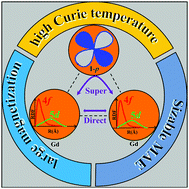Prediction of a two-dimensional high-TC f-electron ferromagnetic semiconductor†
Abstract
Two-dimensional (2D) ferromagnetic semiconductors (FMSs) exhibit novel spin-dependent electronic and optical properties, opening up exciting opportunities for nanoscale spintronic devices. However, experimentally confirmed 2D FMSs based on transition metal ions are rather limited and their performances are not satisfactory, e.g. typically with low Curie temperatures and small magnetic signals. Different from most known 2D magnets based on d-electrons, here an exotic 2D FMS based on rare-earth ions with f-electrons, a GdI2 monolayer, is predicted to have a large magnetization (8 μB f.u.−1), whose ferromagnetism can survive near room temperature (241 K). In addition, with a small exfoliation energy from its layered van der Waals (vdW) bulk, this GdI2 monolayer holds excellent dynamical and thermal stabilities, making our prediction promising in experiments. Our prediction not only offers a compelling FMS for spintronics, but also provides an alternative route to acquire more high-performance 2D FMSs, going beyond pure d-electron compounds.

- This article is part of the themed collections: Materials Horizons 10th anniversary regional spotlight collection: China and 2020 Materials Horizons most popular articles


 Please wait while we load your content...
Please wait while we load your content...